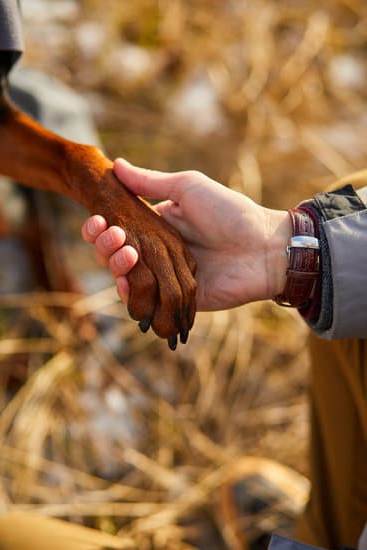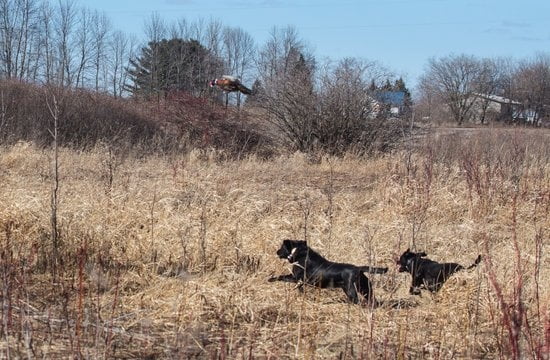Military Working Dogs (MWDs) play a vital role in ensuring the safety and success of various defense operations. These highly trained canines serve alongside their human counterparts, utilizing their exceptional abilities to detect explosives, locate missing persons, and provide valuable support in combat situations. At Lackland Air Force Base, the primary training facility for MWDs in the United States, these remarkable dogs undergo an extensive and rigorous program to prepare them for their crucial duties.
Lackland Air Force Base, located in San Antonio, Texas, has a long-standing history of producing some of the most skilled MWDs in the world. The base is dedicated to providing top-notch training to ensure that each canine receives the necessary skills and knowledge required for its specific military function. From patrol dogs to specialized detection units, Lackland’s Dog Training School offers a comprehensive curriculum that covers obedience training, detection skills, apprehension techniques, and more.
The selection process for MWD training at Lackland is thorough and meticulous. Only dogs with specific traits and characteristics are chosen as candidates for this demanding program. Trainers carefully evaluate potential recruits based on their intelligence, fearlessness, endurance, and adaptability. Through this rigorous screening process, only the most suitable dogs are selected to become future MWDs.
Background on Lackland Air Force Base
Lackland Air Force Base, located in San Antonio, Texas, has become synonymous with military working dogs (MWDs) training in the United States. As the primary training facility for MWDs, Lackland AFB plays a crucial role in producing highly skilled and effective canines that serve alongside their human counterparts in various military operations.
With a rich history dating back to its establishment in 1942, Lackland AFB has consistently maintained its commitment to excellence in MWD training. The base’s dedication to producing top-quality MWDs is reflected in its state-of-the-art facilities and experienced trainers who possess a deep understanding of canine behavior and training methodologies.
Lackland AFB’s reputation as the premier training facility for MWDs is further solidified by the rigorous selection process used to identify suitable candidates for training. Trainers look for specific traits and characteristics such as intelligence, agility, courage, and an unwavering loyalty to their handlers. These qualities are essential for MWDs to perform tasks ranging from explosive detection to search and rescue missions.
| Location | San Antonio, Texas |
|---|---|
| Established | 1942 |
| Primary Role | Military Working Dog Training |
| Facilities | State-of-the-art facilities equipped with specialized equipment for different aspects of MWD training. |
Lackland AFB takes great pride in providing a comprehensive training curriculum for MWDs. The program encompasses various components to ensure a well-rounded education for the canines. This includes obedience training, where dogs are taught to respond to commands promptly and without hesitation. Detecting explosives, drugs, or any other prohibited substances is another crucial skill that MWDs develop during their training. Finally, apprehension techniques are taught to enable the dogs to safely subdue potential threats.
In summary, Lackland Air Force Base stands as a testament to the importance of military working dog training and the significant role it plays in defense operations. Through its rigorous selection process and comprehensive training curriculum, Lackland produces highly skilled MWDs that contribute to successful military missions worldwide. As we delve deeper into this article, we will explore the specific elements involved in MWD training at Lackland AFB and highlight some exceptional graduates from their esteemed program.
The Selection Process
The selection process for military working dog (MWD) training at Lackland Air Force Base is a rigorous and thorough procedure designed to identify the most suitable candidates. This section will delve into the various steps involved in selecting potential MWDs and the crucial traits and characteristics that trainers look for in these dogs.
The Importance of Selecting the Right Candidates
Choosing the right candidates for MWD training is crucial as it sets the foundation for a successful career in military operations. Trainers at Lackland Air Force Base understand the significance of selecting dogs with specific traits, temperaments, and abilities to excel in their roles as MWDs. These dogs will be expected to perform tasks such as patrol, explosive detection, apprehension techniques, search and rescue missions, and support during combat situations.
Criteria for Selection
Trainers at Lackland Air Force Base use a variety of methods to identify suitable candidates for MWD training. They assess factors such as physical fitness, size, intelligence, sociability, temperament, and work drive. The dogs chosen need to possess a balance of these qualities while also demonstrating aptitude and potential for learning.
Physical fitness plays a vital role in determining whether a dog is suitable for training as an MWD. Dogs with robust health profiles can endure challenging conditions that may be encountered during their careers. Size is another important consideration; larger breeds are generally preferred due to their strength and ability to carry out physically demanding tasks.
Furthermore, trainers pay close attention to a dog’s temperament during the selection process. The desired temperament varies depending on the intended task; some dogs need to be confident yet sociable when interacting with civilians, while others must exhibit strong protective instincts when guarding their handlers or carrying out specialized operations.
Training Curriculum at Lackland
At Lackland Air Force Base, the training curriculum for Military Working Dogs (MWDs) is comprehensive and well-rounded. MWDs go through an extensive training program that equips them with the skills necessary to contribute effectively to military operations. This section will provide a glimpse into the training curriculum at Lackland, highlighting the various components and techniques used to train these highly skilled canine soldiers.
Obedience Training
One of the foundational aspects of MWD training is obedience training. Dogs are taught basic commands such as sit, stay, and lie down. They learn to respond promptly to verbal commands and hand signals from their handlers. Obedience training is instrumental in maintaining control over MWDs in high-stress situations during missions.
Detection Skills
Another critical component of MWD training is detection skills. MWDs are trained to detect a wide range of substances, including narcotics, explosives, and contraband. Through extensive scent detection exercises and exposure to various scents, dogs develop the ability to locate hidden items accurately. Their keen olfactory senses make them invaluable assets in detecting potential threats before they pose harm.
Apprehension Techniques
Training MWDs in apprehension techniques is essential for their role in security operations. These techniques enable the dogs to subdue individuals who may pose a threat or attempt to evade capture. Trainers teach MWDs how to bite on command without causing excessive harm and also train them on proper release commands. Apprehension techniques ensure that MWDs can assist military personnel effectively in restraining suspects when necessary.
The comprehensive nature of the training curriculum at Lackland Air Force Base ensures that MWDs receive adequate preparation for their critical responsibilities within military operations. By focusing on obedience training, detection skills, and apprehension techniques, these dogs become well-rounded assets in protecting military personnel and achieving mission success.
MWD Success Stories
Lackland Air Force Base’s Dog Training School has a long history of producing exceptional Military Working Dogs (MWDs) that have gone on to achieve remarkable success in their roles. These brave and highly skilled dogs have demonstrated their abilities in a variety of military operations, showcasing the effectiveness of the comprehensive training they receive at Lackland. Here are just a few notable MWD graduates from Lackland who have made significant contributions to the nation’s defense:
Saving Lives
One standout graduate is Sergeant Rex, a German Shepherd who served as an Explosive Detection Dog during his tenure. Deployed to Afghanistan, Rex was responsible for saving countless lives by sniffing out hidden explosives and bombs planted by insurgents. His incredible olfactory senses and rigorous training enabled him to locate hidden caches of weapons and identify dangerous threats in high-risk areas.
Detecting Explosives
Another remarkable MWD graduate is Staff Sergeant Django, a Belgian Malinois who excelled in explosive detection duties as well. Django proved instrumental in several operations, achieving incredible success by locating improvised explosive devices (IEDs) before they could cause harm to military personnel or civilians. His impeccable detection skills and dedication to duty earned him numerous accolades for his service.
Contributing to Successful Operations
Sergeant Major Mike, a Labrador Retriever mix, also deserves recognition for his invaluable services as a Search and Rescue/Mine Detection Dog. During deployments overseas, Mike played a vital role in locating missing persons, sniffing out buried mines, and helping clear areas for safe passage during military operations. His keen sense of smell and unwavering loyalty contributed significantly to the success of complex missions.
These notable MWD success stories highlight just some of the remarkable achievements accomplished by graduates from Lackland’s training program. It is crucial to acknowledge the dedication and hard work put into training these dogs to ensure their effectiveness in military operations. The continued success of Lackland graduates underscores the importance of investing in the development and support of MWD training programs at this prestigious institution.
Challenges Faced by MWDs
Training military working dogs (MWDs) is a complex and demanding process that comes with its fair share of challenges. However, these roadblocks can be overcome with the right approach, patience, and dedication from both trainers and the dogs themselves. This section will explore some of the common hurdles encountered during MWD training and how they are addressed.
One significant challenge during MWD training is ensuring the dogs maintain a high level of focus and concentration amidst distractions. In real-life military operations, there are numerous distractions such as loud noises, crowds, and unfamiliar environments. Therefore, it is crucial to acclimate the dogs to these situations during training to ensure they can perform their duties effectively. Trainers utilize various techniques to expose the dogs to distractions gradually while reinforcing their obedience commands.
Another obstacle faced during training is building a strong bond between the handler and the MWD. These dogs must trust their handlers implicitly as they rely on them for guidance and direction in high-pressure situations. Establishing trust requires time, consistency, and positive reinforcement methods. Trainers work closely with handlers to develop effective communication and teamwork skills through exercises that promote mutual understanding.
Adaptability is also key when it comes to successful MWD training. Each dog has its own unique personality traits and capabilities that need to be harnessed efficiently. Trainers must carefully assess each dog’s strengths and weaknesses to tailor their training plans accordingly. Additionally, they must be prepared for unexpected challenges or setbacks that may arise during the training process. Flexibility in training methods allows trainers to adjust their approach as needed while still maintaining high standards of performance.
Passing Rates and Statistics
At Lackland Air Force Base, the primary training facility for Military Working Dogs (MWDs) in the United States, a rigorous and comprehensive training program is implemented to ensure that each dog graduates with the necessary skills and abilities to serve effectively in defense operations. The passing rates and statistics of MWDs graduating from Lackland showcase the high success rate of this training program.
Each year, a significant number of dogs are selected to undergo training at Lackland. The selection process is meticulous, as trainers carefully evaluate each candidate based on specific traits and characteristics. Only dogs that display strong drive, intelligence, agility, and adaptability are chosen for training. This rigorous selection process ensures that only the most suitable candidates enter the program.
Once selected, the dogs embark on an intensive journey at Lackland’s Dog Training School. The curriculum covers various aspects crucial to becoming a successful MWD. Obedience training forms the foundation of their education, where dogs learn to respond to basic commands such as sit, stay, and heel. From there, they progress to specialized training in detection skills, which includes explosives and narcotics detection. Additionally, apprehension techniques are taught to prepare dogs for seeking out and detaining suspects when necessary.
The passing rates at Lackland are impressive, with a majority of dogs successfully completing their training. While the exact statistics may vary from year to year depending on factors such as class size and individual abilities, there is consistently a high level of success among MWD graduates from Lackland’s Dog Training School. These passing rates reflect not only the dedication of the trainers but also the innate abilities and intelligence of these remarkable animals.
Overall, it is evident that Lackland’s Dog Training School plays an essential role in producing well-trained MWDs who go on to make immense contributions in military operations. The passing rates and statistics serve as a testament to both the effectiveness of the training program and the remarkable capabilities of these highly skilled dogs. The success achieved at Lackland highlights the importance of ongoing support for training programs and the continuing need for highly trained MWDs in defense operations.
Life After Training
Once the military working dogs (MWDs) at Lackland Air Force Base complete their rigorous training program, they are ready to be deployed and serve alongside their human handlers. These highly skilled canine teams play a crucial role in a wide range of military operations, including explosive detection, search and rescue missions, and patrol duties. The deployments not only provide real-life scenarios for the MWDs to apply their training but also contribute significantly to overall mission success.
The deployment process for MWDs involves careful coordination with their handlers and other military units. Before being sent to their designated locations or assignments, these canine teams go through specialized pre-deployment training programs. During this phase, they receive additional instruction that prepares them specifically for the challenges they may face on deployment. This may include acclimatization to different environments, desensitization exercises to loud noises or crowded areas, and reinforcement of specialized skills such as searching vehicles or buildings.
Once deployed, MWDs work side by side with their handlers in high-stress situations where their expertise is put to the test. Their primary responsibilities vary depending on the specific mission and location. For instance, some MWDs specialize in explosive detection and are tasked with searching for improvised explosive devices (IEDs) or mines in combat zones. Others are trained in apprehension techniques and function as patrol dogs to provide security and protection during military operations.
After completing several successful tours of duty, MWDs eventually reach retirement age. At this stage, these loyal canines transition into civilian life and receive ongoing support from various programs dedicated to retired military working dogs. The United States Air Force Military Working Dog School Retiree Program provides medical care for these retired heroes as well as assisting in finding suitable adoptive homes once they leave active service.
Conclusion
In conclusion, military working dogs (MWDs) play an essential role in defense operations, contributing to the safety and success of missions. Lackland Air Force Base’s Dog Training School holds a vital position as the primary training facility for MWDs in the United States. The comprehensive and rigorous training curriculum at Lackland ensures that these dogs are equipped with the necessary skills to excel in their roles.
The selection process at Lackland is meticulous, focusing on identifying candidates with the right traits and characteristics for MWD training. This attention to detail ensures that only the most suitable dogs are chosen and prepared for their future duties.
Throughout their training, MWDs undergo various components of the curriculum, including obedience training, detection skills, and apprehension techniques. The program at Lackland is designed to develop well-rounded and highly skilled MWDs who can adapt to different situations in the field.
Notable graduates from Lackland have showcased their exceptional abilities by saving lives, detecting explosives, and contributing to successful military operations. Their successes underscore the importance of effective training programs like those offered at Lackland.
Despite facing challenges along the way, such as patience, discipline, and adaptability during training exercises, MWDs overcome these roadblocks with guidance from experienced trainers. These hurdles further contribute to molding these dogs into reliable assets within defense operations.
Passing rates and statistics regarding MWDs successfully completing their training at Lackland demonstrate both the high standards maintained by trainers and the commitment shown by these incredible animals. These numbers highlight the effectiveness of Lackland’s Dog Training School in producing competent and capable MWDs.
After graduating from Lackland’s Dog Training School, MWDs are deployed into military operations where they continue to provide valuable contributions. The ongoing support systems provided for retired MWDs ensures that they receive proper medical care and can enjoy a fulfilling life after serving their country dutifully.
Frequently Asked Questions
Are military dogs higher rank than their handlers?
Military dogs are not higher rank than their handlers. In the military, the hierarchical structure is based on human ranks rather than animal ranks.
Handlers are typically enlisted personnel and they are given specific training to work with military dogs effectively. While military dogs hold a critical role in operations and possess specialized skills, they ultimately serve alongside their human handlers as a team, working together to fulfill their mission objectives.
How long does it take to become a dog handler in the Air Force?
The duration it takes to become a dog handler in the Air Force can vary depending on several factors. Generally, the process involves completing basic training followed by specialized training in canine handling.
Basic military training lasts for approximately eight weeks, after which selected individuals may be chosen for dog handler training programs. These programs can last anywhere from 90 days to six months, depending on the specific requirements and intensity of the course.
How hard is it to become a military dog handler?
Becoming a military dog handler requires dedication, commitment, and meeting specific criteria set by the branch of service involved. The process can be demanding due to the rigorous physical and mental training required for both the handler and the dog. Additionally, candidates must demonstrate an understanding of canine behavior, care, and obedience training techniques while also possessing necessary teamwork and leadership skills to effectively handle a military dog in various situations.
The selection criteria may include physical fitness assessments, interviews, background checks, and aptitude tests. While challenging, those who successfully complete the necessary training have the opportunity to work closely with highly trained dogs in vital roles within military operations.

Welcome to the blog! I am a professional dog trainer and have been working with dogs for many years. In this blog, I will be discussing various topics related to dog training, including tips, tricks, and advice. I hope you find this information helpful and informative. Thanks for reading!





